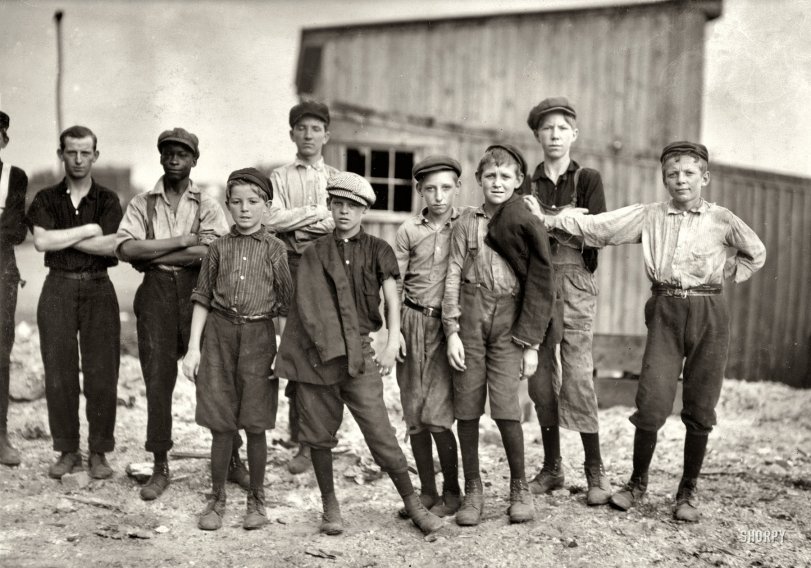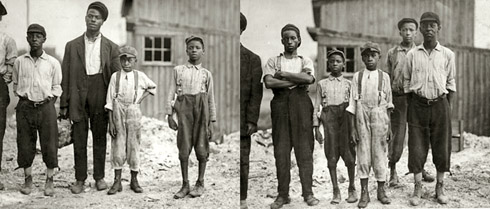


Framed or unframed, desk size to sofa size, printed by us in Arizona and Alabama since 2007. Explore now.
Shorpy is funded by you. Patreon contributors get an ad-free experience.
Learn more.

- Baldwin 62303
- Baldwin VO-1000
- Cold
- No expense spared
- Tough Guys
- Lost in Toyland
- And without gloves
- If I were a blindfolded time traveler
- Smoke Consumer Also Cooks
- Oh that stove!
- Possibly still there?
- What?!?
- $100 Reward
- Freeze Frame
- Texas Flyer wanted
- Just a Year Too Soon
- WWII -- Replacing men with women at the railroad crossing.
- Yes, Icing
- You kids drive me nuts!
- NOT An Easy Job
- I wonder
- Just add window boxes
- Icing Platform?
- Indiana Harbor Belt abides
- Freezing haze
- Corrections (for those who care)
- C&NW at Nelson
- Fallen Flags
- A dangerous job made worse
- Water Stop
Print Emporium
Night Shift: 1911

June 1911. Alexandria, Virginia. "Old Dominion Glass Co. A few of the young boys working on the night shift at the Alexandria glass factory. Negroes work side by side with the white workers." Photograph by Lewis Wickes Hine. View full size.
Old Dominion Glass
Washington Post, Feb 24, 1907.Mammoth Bottle Plant.
Old Dominion Glass Company One of Alexandria's Big Industrial Concerns.
…
The factory is the largest south of New Jersey. Its daily output is in the neighborhood of two carloads. The number of bottles varies, as it takes a much longer time to make the large bottles than it does to make the small vials. A team, however, turns out from five to six thousand bottles a day. The Old Dominion Glass Company makes a specialty of beer and soda bottles, which are not only guaranteed to stand the highest pressure from within, but also the hottest steaming. Not less than 2,000 molds are kept by the firm. These vary in size and style from the one dram druggist vial to a fifteen-gallon carboy.This plant covers four or five acres and employs not less than two hundred and fifty blowers and molders. Here everything in the manufacture of the glass bottle may be seen. First the visitor is carried to the enormous sand pits, where hundreds of tons of glistening white sand is being hauled away to be mixed with soda, ash and lime in chemically exact proportions. This mixture, which has to be carried out with great accuracy in order to secure the best results, requires the employment of a special chemist for that purpose. It is then placed in an enormous furnace or retort. Here it is subjected to a temperature that is almost inconceivable. The foreman will tell that this mass has to be brought to a temperature of 2,800 degrees before it will fuse. This intense heat is obtained by burning unrefined coal gas under heavy pressure. At this plant there is a separate manufacturing department for this gas, and here many tons of coal are consumed daily in order to get the necessary amount of gas.
As the sand, lime and soda ash fuse into a liquid mass, it flows to the end of the furnace, where swarthy workmen, scantily clad, stand with long iron pipes. They dip the ends of the pipes into the white-hot mass and draw out a small bulb of it. This they roll on slabs until it cools to an orange color. It is then thrust into a mold and the glass blower inflates the bulb, making it fill the recess. The bottle is then taken out of the mold with pincers and placed upon a pair of scales. Here one must stop to marvel. Every bottle tips the scale and makes it balance absolutely. It is this feature that enables the glass blower to make from eight to ten dollars a day. If he should get the fraction of an ounce more of the liquid mass on the end of the iron pipe, the thickness of the bottle would vary and of course the weight would be a variable quantity.
…
Night Shift: 1911
Almost all the workers in factories and mills at this time were white. The country was segregated - remember? That's why it is very rare to see an African-American in Hine's child labor photos, especially in a state like Virginia. The fact that this situation is an exception is the only reason Hine mentioned it. That's all there is to it. Hine was not a racist. He believed deeply that everyone had dignity and should be treated with respect. But he was not a 1960s-style civil rights worker. Had he been a photojournalist in the days of the bus boycotts and the Selma marches, his camera would have been right there on the front lines.
Working together
At a time when blacks and whites weren't always seen working together, even if they did. It is a plain statement of fact by the photographer that they work together at the mines.
Called Out
The boy with half a jacket on (2nd from right in front) looks like he's scared enough to pee his pants. My imagination tells me that the boys to either side of him (especially the one with his hand against his shoulder) plan to beat him up on his way home from work, and they've been letting him know that all day.
Glass Could Be Half Full
Why must Hine's comment be interpreted in the negative? As he was documenting child labor, it may have struck him as a pleasant surprise that the boys worked together regardless of race. Encountering such comraderie in Virginia a mere 46 years after the end of the Civil War might have had a lot to do with it.
[The caption information comes from more than one photo. Hine took several pictures of just the black workers. - Dave]

Expressions on their faces
I see Apprehension, Anger, Fear, Indifference, not much Joy though.
Hey you - photog!
Kid on the right appears to be saying: "here, hold my jacket while I give that photog a bunch in the nose!"
Two things come to mind
1. The boy on the far right seems to think he's a pretty tough guy.
2. The variety of the facial features show how unique we all are. I'm glad God didn't make us all from the same mold. It would have been pretty boring by now.
Huh?
Actually, I thought Mr. Hine's note was taking pains to point out that at lower class levels the races were mixing - over the dual issue of working to pay rent and provide food for a family. Nowhere does Hine apply a pejorative sense. He had been a crusader who used his art to help end child labor. So I don't think he would have minded at all.
Just the facts
I'm not getting any kind of point of view from reading the associated statement. Sounded like the writer was stating a simple fact. Maybe the writer felt he needed to explain why the black kid was in the photo.
Those poor children. My heart is heavy just looking at that photo. They should be in school or playing. And yet, from their expressions I get the feeling that these kids ended up okay. I wish I could say the same thing about of lot of the young boys around today.
How times have changed
And kids these days think they have it hard when the internet goes down for an hour.
"Side by side with the white workers"
It seems as if Mr. Hine wants to say that that is a shame apart from young boys working.
Perspectives Do Change
When Mr. Hine noted that "Negroes work side by side with the white workers," I don't think he thought that was a good thing.
























On Shorpy:
Today’s Top 5